How to Enhance Customer Service Using Email Ticketing
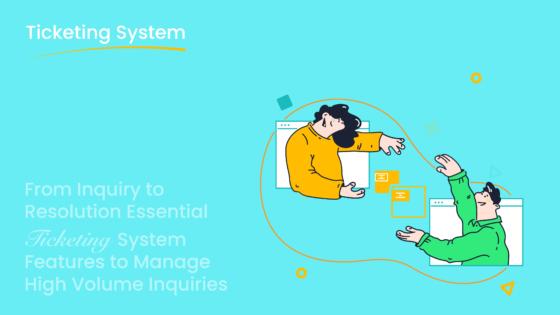
Email ticketing systems have transformed how businesses handle customer service. These systems organize inquiries into manageable tickets, ensuring faster resolutions and improved efficiency. With ticket volumes expected to grow by 75% this year, adopting such systems has become essential. Companies like Essentialist achieved a 97% satisfaction rating by routing tickets effectively and managing customer context seamlessly.
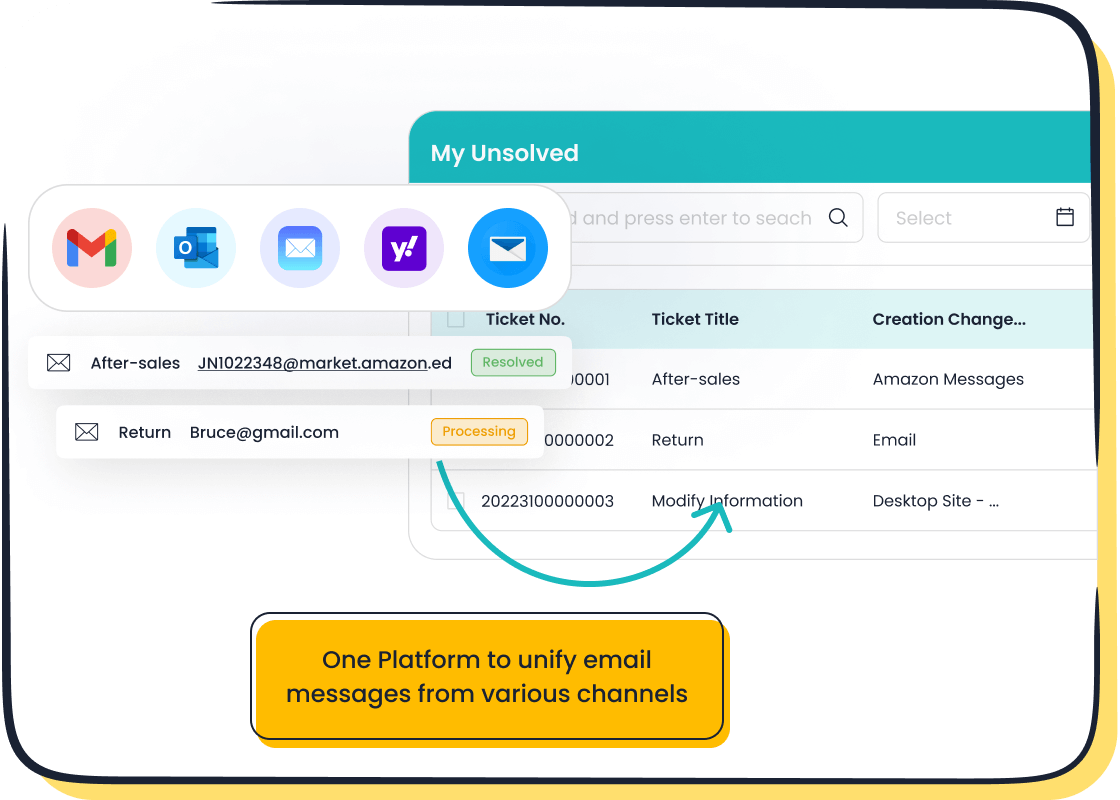
Sobot's customer service email ticketing system takes this further by unifying communication across channels and automating tasks like ticket routing and SLA management. These features reduce inbound discussions by 20% and boost customer satisfaction to over 95%. Modern tools like Sobot not only enhance service efficiency but also build stronger customer relationships. By adopting advanced solutions, you can stay ahead in delivering exceptional support.
Understanding Customer Service Email Ticketing Systems
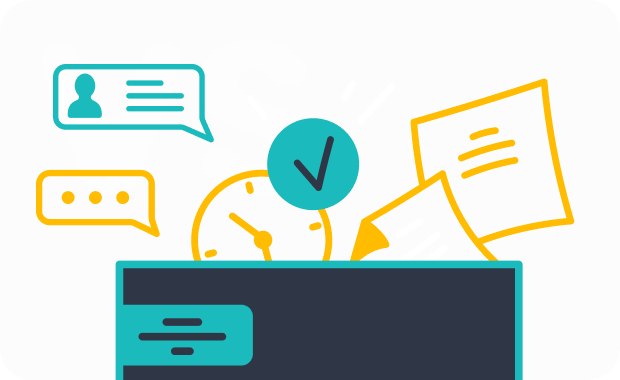
What Is a Customer Service Email Ticketing System?
A customer service email ticketing system is a software tool that helps you manage and resolve customer inquiries efficiently. It converts incoming emails into tickets, which are then tracked and organized for resolution. This system ensures that no customer query gets overlooked, improving your service delivery. By prioritizing and categorizing tickets, you can address urgent issues faster and allocate resources effectively.
For example, if a customer emails about a delayed order, the system creates a ticket with all the necessary details. This ticket is then assigned to the appropriate agent, ensuring a quick response. Metrics like response time and resolution rate help you measure the system's effectiveness. These tools are essential for optimizing IT support processes and enhancing customer satisfaction.
Core Components of a CRM Ticketing System
A CRM ticketing system consists of several key components that streamline your customer service operations. These include:
- Ticket Creation and Submission: Customers can submit tickets through email or forms, capturing essential details like issue type and urgency.
- Ticket Assignment and Management: Tickets are automatically or manually assigned to agents, ensuring timely responses.
- Tracking and Communication: Real-time updates keep both customers and agents informed about ticket progress.
- Knowledge Base: Agents can access solutions for common problems, speeding up resolutions.
- Reports and Analytics: Tools track metrics like ticket volumes and resolution times, providing insights for improvement.
| Core Functionality | Description | Benefits |
|---|---|---|
| Ticket creation and submission | Users submit tickets through forms or email, capturing key details. | Centralizes customer queries, improving satisfaction and reducing response times. |
| Ticket assignment and management | Tickets are assigned to agents automatically or manually. | Ensures timely responses and improves issue tracking. |
| Tracking and communication | Real-time updates and communication channels keep everyone informed. | Enhances customer and agent communication, leading to better service. |
| Knowledge base | Access to solutions for common problems improves resolution speed. | Reduces time spent on resolving issues, increasing efficiency. |
| Reports and analytics | Tools track ticket volumes, resolution times, and agent performance. | Provides insights to improve processes and operational efficiency. |
These components make a CRM ticketing system indispensable for businesses aiming to deliver exceptional customer service.
How Sobot's Ticketing System Stands Out
Sobot's ticketing system offers unique features that set it apart in the market. It integrates all communication channels, including email, voicemail, and chat, into a single platform. This unification ensures that you can manage customer interactions seamlessly. The system also automates ticket routing and prioritization, reducing manual effort and speeding up response times.
For instance, Sobot's SLA management feature allows you to set response and resolution times based on ticket priority. This ensures that high-priority issues are addressed promptly. Additionally, the system provides multilingual support, enabling you to serve a global customer base effectively.
| Metric | Description |
|---|---|
| First Response Time | Average time taken for a first response from an agent on a ticket, indicating responsiveness. |
| Average Resolution Time | Average time taken to resolve a ticket, including wait times from both agent and customer. |
| Ticket Volume | Total number of tickets received in a certain period, indicating overall support workload. |
| Tickets per Customer | Average ticket received per customer, highlighting areas needing support. |
| Peak Hour Ticket Volume | Ticket volume during peak business hours, aiding in staffing decisions. |
| Channel Distribution | Number of tickets received across various channels, guiding resource optimization. |
| Agent Utilization Rate | Time spent by agents in ticket-related activities, helping balance workload. |
Sobot's system also includes advanced analytics, offering insights into metrics like ticket volume and agent performance. These features help you optimize your operations and improve customer satisfaction. By choosing Sobot, you gain a reliable partner in enhancing your customer service capabilities.
How Customer Support Ticketing Systems Work
Ticket Creation and Categorization
Ticket creation and categorization form the foundation of customer support ticketing systems. When a customer submits an inquiry via email or other channels, the system automatically generates a ticket. This ticket includes essential details like the issue type, urgency, and customer information. Categorizing tickets ensures that similar issues are grouped together, making it easier to manage and resolve them efficiently.
For example, using templates for common issues can reduce ticket creation time from 2 minutes to just 30 seconds. This streamlined process not only saves time but also improves data accuracy. Proper ticket categorization prevents SLA breaches and ensures that urgent issues receive immediate attention. Building a structured workflow for ticket handling helps identify inefficiencies and improves customer support operations.
| Process Improvement | Time Reduction |
|---|---|
| Ticket creation time with templates | 2 minutes to 30 seconds |
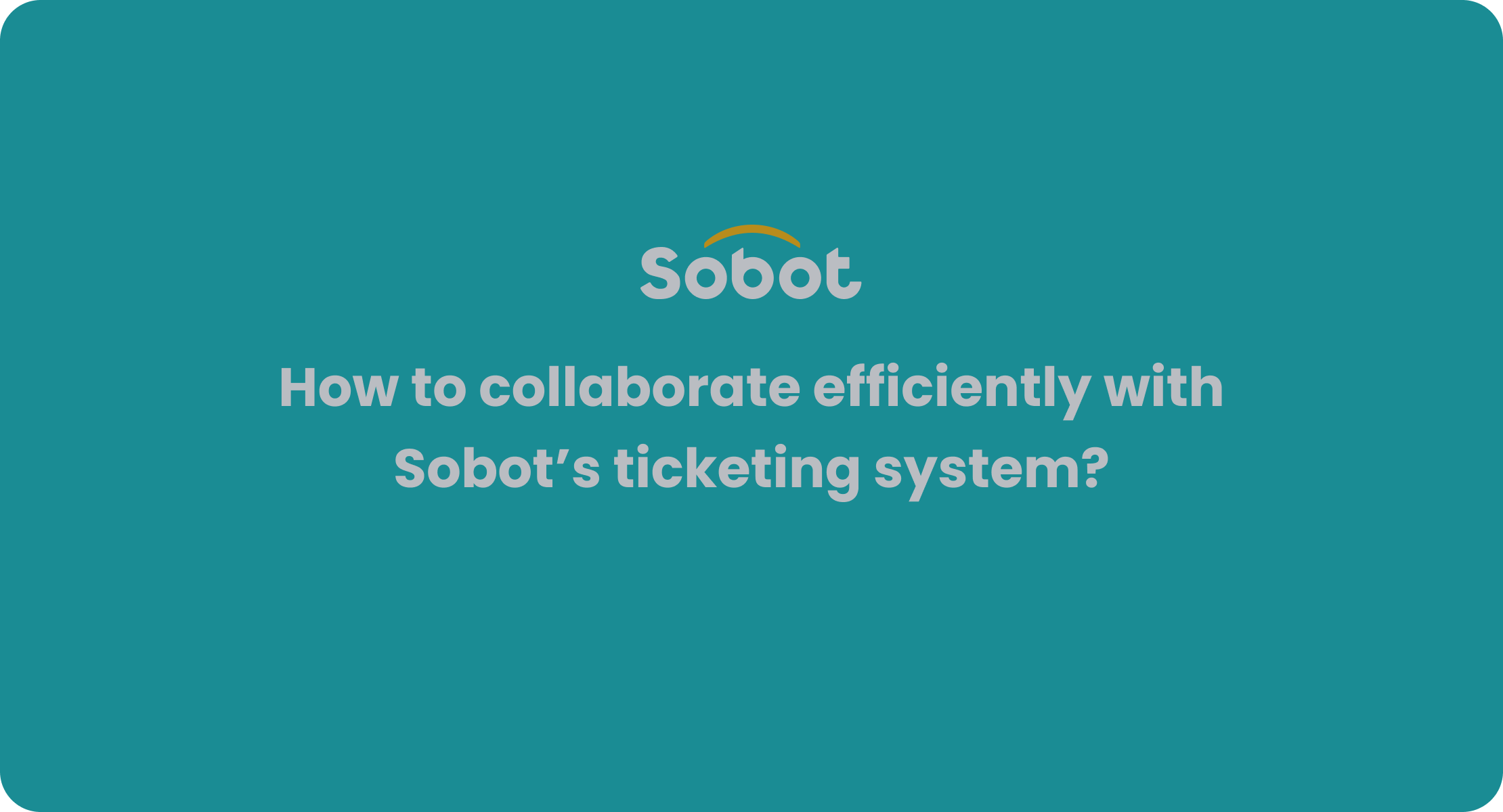
Sobot's ticketing system excels in this area by offering categorized templates and multilingual support. These features simplify ticket creation and ensure that your team can handle inquiries from a global audience effectively.
Automated Assignment and Prioritization
Automated assignment and prioritization are critical for improving customer support efficiency. Once a ticket is created, the system uses predefined rules to assign it to the most suitable agent. Factors like agent expertise, workload, and ticket urgency determine the assignment. This automation eliminates manual errors and ensures faster response times.
Prioritization ensures that high-impact issues are addressed first. For instance, an automated system can classify tickets based on urgency levels, ensuring that critical problems are resolved promptly. According to industry data, 66% of support leaders believe that automation significantly boosts team efficiency. Automating ticket management allows your team to focus on complex tasks rather than routine assignments.
| Evidence Type | Description |
|---|---|
| Automation Impact | 66% of support leaders are excited about leveraging AI and automation to increase team efficiency. |
| Ticket Management | Automating ticket creation, assignment, and tracking saves time and minimizes errors. |
| Prioritization | Automated systems assign urgency levels to requests based on various factors. |
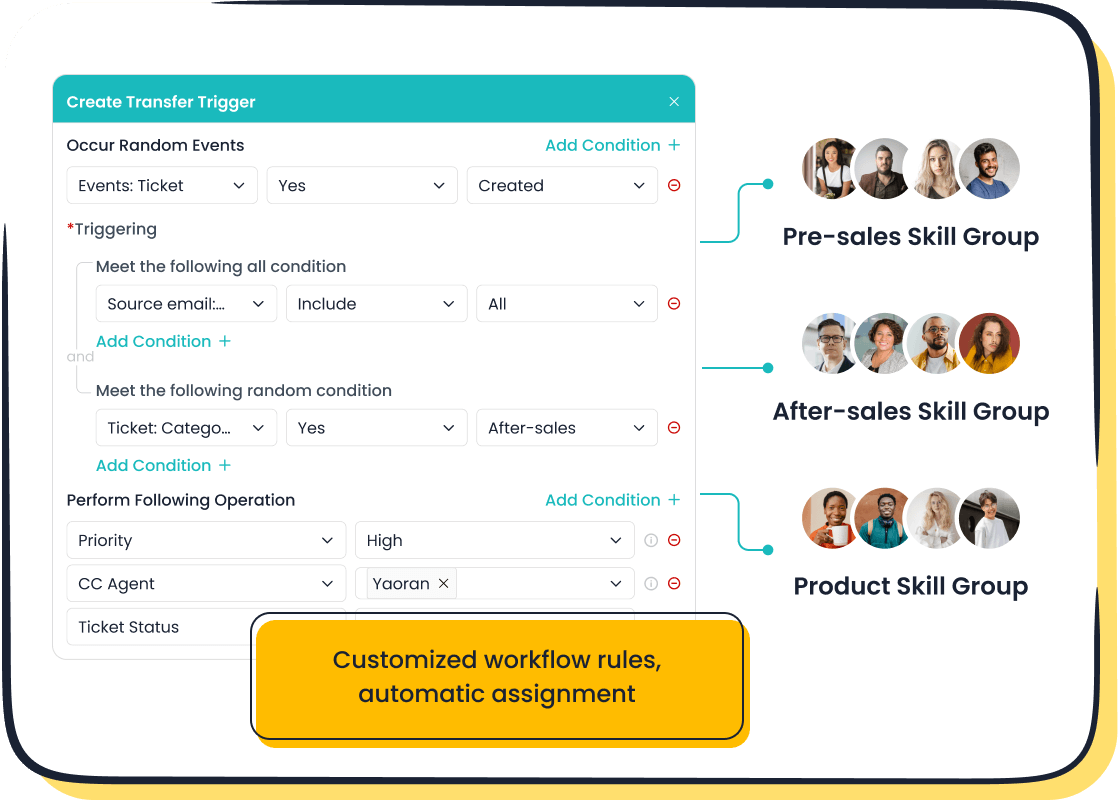
Sobot's CRM ticketing system leverages AI-powered automation to route tickets accurately and prioritize them effectively. This ensures that your team can deliver faster response times and maintain high customer satisfaction.
Resolution and Follow-Up Processes
The resolution and follow-up processes are where customer service efficiency truly shines. Once an agent resolves a ticket, the system tracks metrics like resolution time and first contact resolution rate (FCR). These metrics help you measure the effectiveness of your customer support operations.
Follow-up processes ensure that customers are satisfied with the resolution. For example, sending a quick survey after closing a ticket can provide valuable feedback. Metrics like Net Promoter Score (NPS) and Customer Effort Score (CES) highlight areas for improvement. A high FCR rate indicates that your team resolves issues effectively on the first attempt, reducing the need for ticket reopens.
| Metric | Description |
|---|---|
| First Contact Resolution Rate (FCR) | A high FCR signifies efficient and effective support. |
| Resolution Time | The speed of ticket closure reflects process efficiency; faster resolutions lead to happier customers. |
| Net Promoter Score (NPS) | Measures customer loyalty and likelihood to recommend the service. |
| Customer Effort Score (CES) | Evaluates the ease of the customer's experience, aiming for minimal effort. |
Sobot's ticketing system enhances these processes with features like SLA reminders and trusted analytics. These tools help you monitor performance and continuously improve customer support operations.
Benefits of Using a Customer Service Ticketing System

Faster Response Times and SLA Management
A customer service ticketing system significantly improves response times and ensures compliance with Service Level Agreements (SLAs). By automating ticket routing and prioritization, these systems help your team address customer inquiries faster. For instance, Sobot's CRM ticketing system uses AI-powered automation to assign tickets to the right agents based on urgency and expertise. This reduces delays and ensures that high-priority issues are resolved promptly.
Tracking performance metrics like response times and SLA compliance becomes easier with a ticketing system. Key metrics include:
- Response Times: Measure how quickly your team replies to customer inquiries.
- First-Contact Resolution Rate: Tracks the percentage of tickets resolved in a single interaction.
- Average Handling Time (AHT): Indicates the time taken from ticket submission to resolution.
- Tickets Resolved Within SLA Timescales: Highlights your team's ability to meet SLA terms.
- Customer Satisfaction Scores (CSAT): Reflects how happy customers are with the support they receive.
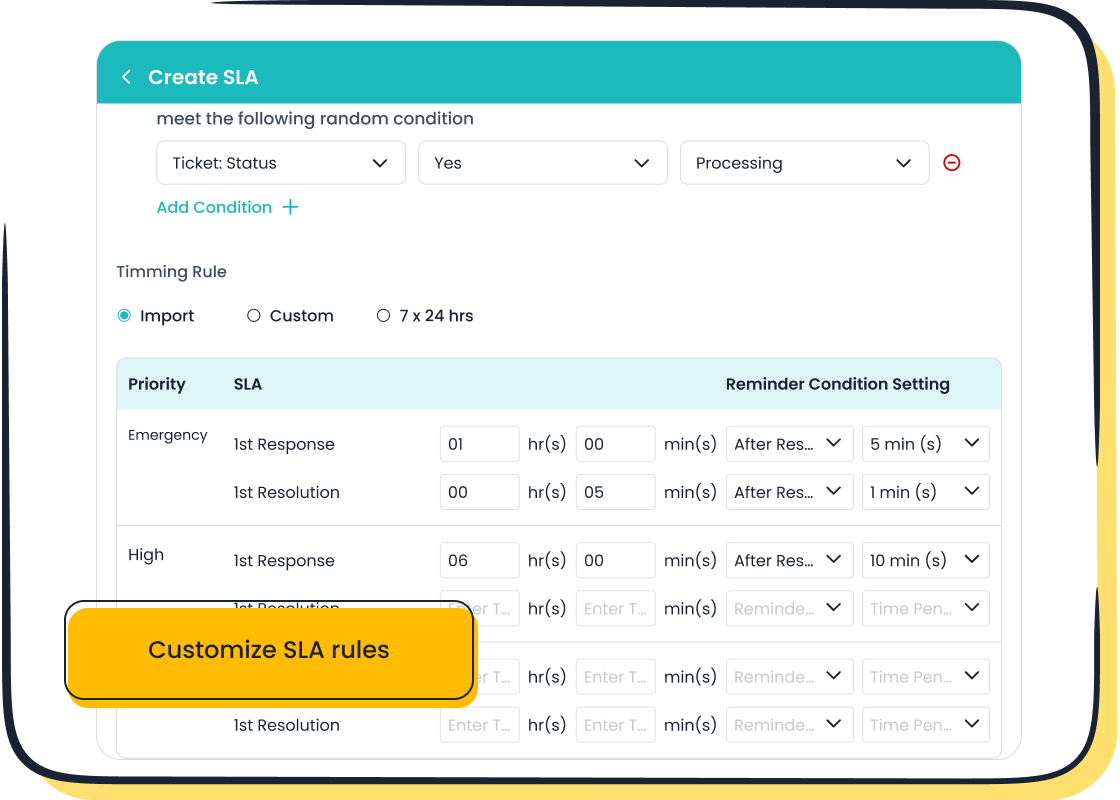
Sobot's system also includes SLA reminders, ensuring your team stays on track to meet deadlines. By reducing response times and improving SLA compliance, you can enhance customer satisfaction and build trust with your audience.
Improved Organization and Workflow Efficiency
A CRM ticketing system streamlines your customer service operations by organizing inquiries into a centralized platform. This eliminates the chaos of managing multiple communication channels separately. With Sobot's unified platform, you can handle emails, voicemails, and chats in one place, improving organization and efficiency.
The system also optimizes workflows by automating repetitive tasks like ticket categorization and assignment. For example, Sobot's custom trigger rules ensure that tickets are routed to the appropriate agents without manual intervention. This reduces errors and allows your team to focus on resolving issues rather than managing processes.
Here’s how workflow efficiency improves with a ticketing system:
| KPI | Description |
|---|---|
| Response Time | Time taken to respond to a ticket. |
| Resolution Time | Time taken to resolve a ticket. |
| Customer Satisfaction | Measure of how satisfied customers are with support. |
| Ticket Delays | Instances where tickets are not resolved in a timely manner. |

By improving organization and efficiency, a ticketing system helps your team handle higher ticket volumes without compromising service quality. Sobot's system, with features like categorized templates and multilingual support, ensures that your team can manage inquiries effectively, even during peak periods.
Enhanced Customer Satisfaction with Sobot's Ticketing System
Customer satisfaction is the ultimate goal of any customer service operation. A CRM ticketing system plays a crucial role in achieving this by providing faster resolutions, personalized support, and consistent communication. Sobot's ticketing system takes this a step further with features designed to enhance customer satisfaction.
For example, the system's "One Customer ID" feature consolidates all customer information into a single view. This allows agents to understand the customer's history and provide tailored solutions. Additionally, Sobot's multilingual support ensures that you can serve a global audience without language barriers.
Metrics like Net Promoter Score (NPS) and Customer Effort Score (CES) help you measure the impact of your customer service efforts. A high NPS indicates that customers are likely to recommend your service, while a low CES shows that they find it easy to get their issues resolved. Sobot's trusted analytics provide insights into these metrics, enabling you to identify areas for improvement.
By adopting Sobot's ticketing system, you can deliver a seamless customer experience that fosters loyalty and drives repeat business. Enhanced customer satisfaction not only improves your brand reputation but also contributes to long-term success.
Data-Driven Insights for Continuous Improvement
In today's fast-paced world, data plays a crucial role in refining customer service operations. A customer service ticketing system equipped with analytics tools can transform how you approach support. By leveraging data-driven insights, you can identify patterns, address inefficiencies, and continuously enhance your processes.
How Data-Driven Insights Improve Customer Support
Data-driven insights provide actionable information that helps you make informed decisions. Here are some ways they enhance your customer service:
- Personalized Support Experiences: Analyzing customer history allows you to tailor responses to individual needs. For example, if a customer frequently inquires about product returns, your system can flag this pattern. This enables agents to offer proactive solutions, improving satisfaction.
- Improved Response Times: Predictive analytics help you anticipate ticket surges during peak periods. By identifying bottlenecks, you can allocate resources effectively and reduce delays.
- Continuous Improvement through Analytics: Regularly reviewing metrics like ticket resolution time and customer satisfaction scores helps you refine strategies. Addressing recurring issues at their root ensures long-term efficiency.
Sobot's Role in Data-Driven Customer Service
Sobot's customer service ticketing system excels in providing trusted analytics. It tracks key metrics such as first response time, resolution rates, and customer satisfaction scores. These insights empower you to monitor performance and identify areas for improvement. For instance, Sobot's SLA reminders ensure that your team meets deadlines, reducing the risk of customer dissatisfaction.
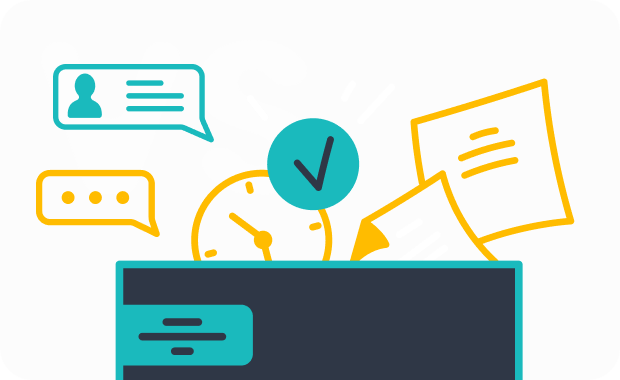
The system also offers multilingual support and a unified platform for managing tickets across channels. This ensures that you can serve a diverse customer base while maintaining consistency. By using Sobot's analytics tools, you can make data-backed decisions that enhance both efficiency and customer satisfaction.
Real-World Impact of Data-Driven Insights
Consider a scenario where your team struggles with delayed responses during holiday seasons. By analyzing ticket volume trends, you can predict high-demand periods and prepare accordingly. Sobot's predictive analytics feature helps you allocate agents to handle peak workloads. This proactive approach not only reduces response times but also boosts customer loyalty.
Additionally, tracking metrics like Net Promoter Score (NPS) and Customer Effort Score (CES) provides valuable feedback. A high NPS indicates that customers are likely to recommend your service, while a low CES shows that they find it easy to resolve issues. These insights guide you in optimizing your support strategies.
Key Metrics to Monitor
To achieve continuous improvement, focus on these essential metrics:
| Metric | Purpose |
|---|---|
| First Response Time | Measures how quickly your team responds to tickets, reflecting responsiveness. |
| Resolution Time | Tracks the time taken to resolve issues, highlighting efficiency. |
| Customer Satisfaction (CSAT) | Gauges customer happiness with the support they receive. |
| Net Promoter Score (NPS) | Indicates customer loyalty and likelihood to recommend your service. |
| Ticket Volume Trends | Helps you identify peak periods and allocate resources effectively. |
By monitoring these metrics, you can ensure that your customer service ticketing system operates at peak efficiency.
Why Data-Driven Insights Matter
Data-driven insights are not just about numbers; they are about understanding your customers better. They help you identify what works and what doesn’t. With tools like Sobot's ticketing system, you gain the ability to adapt quickly to changing customer needs. This adaptability fosters trust and builds stronger relationships with your audience.
Incorporating analytics into your customer service strategy ensures that you stay ahead of the competition. By continuously improving your processes, you create a support system that not only resolves issues but also delights customers.
Best Practices for Implementing a Customer Service Email Ticketing System
Selecting the Right Customer Support Ticketing System
Choosing the right customer support ticketing system is essential for delivering a better customer experience. Start by evaluating systems based on key metrics like acknowledgment rate, resolution time, and customer satisfaction. For example, benchmarks such as a 60-minute time to first response and a resolution rate above 68.8% indicate high-performing systems.
| Metric | Benchmark Value |
|---|---|
| Acknowledgment rate | 100% |
| Time to first response | 60 minutes |
| Total handle time | 24 hours |
| Number of replies per ticket | less than two |
| Resolution without escalation rate | more than 68.8% |
| Customer satisfaction | 85% |
Scalability for growing businesses should also be a priority. Systems like Sobot’s ticketing solution offer scalability by integrating multiple channels and automating workflows. This ensures your team can handle increasing ticket volumes without compromising efficiency. Look for features like AI and automation to streamline operations and enhance team collaboration.
Training Teams for Effective Use
Proper training ensures your team maximizes the potential of a ticketing system. Regular sessions, held monthly or quarterly, help agents stay updated on new features and common issues. These discussions improve visibility into workflows and enhance resolution rates.
Tracking agent performance is equally important. Metrics like ticket backlog and first-response time highlight areas needing improvement. Recognizing top performers motivates your team and fosters enhanced team collaboration. For example, Sobot’s analytics tools allow managers to monitor service metrics and identify agents requiring additional coaching.
Encourage agents to explore self-service features within the system. This empowers them to resolve tickets faster and reduces dependency on manual processes. A well-trained team not only boosts efficiency but also contributes to a better customer experience.
Leveraging Automation and Customization Features
Automation and customization are vital for optimizing customer support operations. Automating ticket prioritization ensures critical issues receive immediate attention. Categorizing similar tickets allows agents to address multiple inquiries with a single solution, saving time and effort.
Email templates further enhance efficiency. Agents can respond to high volumes of tickets quickly, maintaining consistency in communication. For instance, Sobot’s ticketing system uses AI and automation to route tickets accurately and provide pre-filled templates for common issues. This reduces response times and improves customer satisfaction.
Customization features, such as multilingual support, enable businesses to serve diverse audiences effectively. By leveraging automation and customization, you create a streamlined workflow that adapts to your team’s needs and delivers a better customer experience.
Monitoring and Optimizing Performance with Analytics
Monitoring and optimizing your customer service performance is essential for delivering exceptional support. Analytics tools in ticketing systems provide valuable insights that help you evaluate and improve your operations. By tracking key metrics, you can identify inefficiencies, allocate resources effectively, and enhance customer satisfaction.
Ticketing systems generate various reports to measure performance. For example, ticket volume reports reveal trends and bottlenecks, helping you predict peak periods. Ticket status reports track the progress of issues, ensuring timely resolutions. Additionally, ticket category reports show the distribution of inquiries, allowing you to assign resources where they are needed most. These insights enable you to refine your processes and optimize service delivery.
AI-powered analytics take this a step further by offering predictive insights. For instance, AI can analyze historical data to forecast ticket surges during holidays. This allows you to prepare your team in advance, reducing response times. AI also identifies recurring issues, helping you address root causes and prevent future problems. By leveraging AI, you can make data-driven decisions that improve both efficiency and customer experience.
Consider a scenario where your team struggles with delayed responses. Analytics can highlight the specific times or categories causing delays. With this information, you can adjust staffing levels or provide targeted training. Sobot’s ticketing system excels in this area by offering trusted analytics and smart notifications. These tools help you monitor metrics like first response time and resolution rates, ensuring continuous improvement.
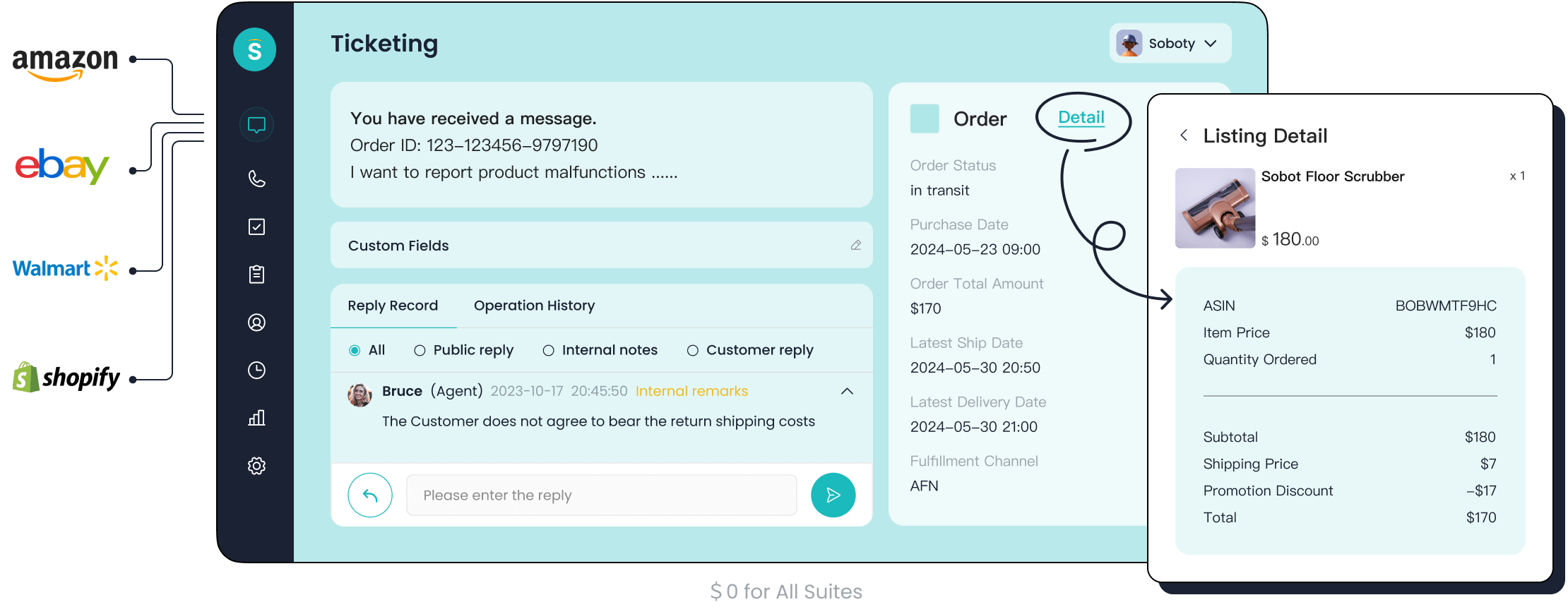
By using analytics effectively, you can transform your customer service operations. Monitoring performance not only helps you meet customer expectations but also builds trust and loyalty. With AI-driven insights, you gain the ability to adapt quickly and stay ahead in a competitive market.
Actionable Steps to Adopt Sobot's Ticketing System Effectively
Assessing Your Customer Service Needs
Before implementing Sobot's ticketing system, you need to evaluate your customer service requirements. Start by identifying the challenges your team faces. For example, are response times too slow? Are inquiries getting lost across multiple channels? Understanding these pain points will help you determine the features you need most, such as SLA management or multilingual support.
Next, analyze your current ticket volume and customer demographics. If your business handles a high volume of inquiries from international customers, Sobot's multilingual capabilities can be a game-changer. Additionally, consider the complexity of your support operations. Businesses with diverse communication channels will benefit from Sobot's unified platform, which integrates email, voicemail, and chat into one system.
By assessing your needs thoroughly, you can ensure that the ticketing system aligns with your goals and enhances your customer service operations.
Planning and Budgeting for Implementation
Effective planning and budgeting are crucial for a smooth implementation. Begin by setting clear objectives. For instance, aim to reduce response times by 20% or improve SLA compliance by 15%. These goals will guide your planning process.
When budgeting, consider both direct and indirect costs. Direct costs include software licensing and training, while indirect costs may involve temporary productivity dips during the transition. The Responsibility Center Management (RCM) budget model can help you allocate resources effectively. This model allows individual units to manage their expenses, improving financial accountability and decision-making.
| Advantage | Impact |
|---|---|
| Safety Enhancements | Reduced risk for field personnel, increased adherence to safety protocols. |
| Time Savings | Speedier verification processes, reduced need for manual data management. |
| Improved Quality | Consistent and accurate documentation, better maintenance and asset tracking. |
| Financial Accountability | Improved budget management, efficient financial reporting and analysis. |
By planning carefully and using a structured budget model, you can ensure a cost-effective implementation of Sobot's ticketing system.
Rolling Out the System and Gathering Feedback
A phased rollout is the best approach for deploying Sobot's ticketing system. Start with a small team or department to test the system's functionality. Use in-app walkthroughs to familiarize agents with the platform. This reduces confusion and minimizes training time.
Once the initial phase is successful, expand the rollout to other teams. Integrate the system with existing tools, such as CRM or e-commerce platforms, to ensure seamless operations. During this process, gather feedback from your team. For example, if agents struggle with a specific feature, provide targeted retraining to address the issue.
- A global logistics company successfully integrated fleet management software with existing systems before expanding its use.
- A manufacturing firm improved adoption rates by retraining users based on feedback about an underutilized feature.
Customer feedback is equally important. Send surveys to measure satisfaction and identify areas for improvement. Metrics like Net Promoter Score (NPS) and Customer Effort Score (CES) can provide valuable insights. By acting on this feedback, you can optimize the system and enhance your customer service operations.
Continuous Improvement Based on Insights
Continuous improvement is essential for maintaining a high-quality customer experience. By analyzing performance metrics and acting on actionable insights, you can refine your processes and achieve long-term success. A customer service ticketing system like Sobot's provides the tools you need to monitor, evaluate, and enhance your operations.
Start by tracking key metrics that reveal areas for improvement. For example, measuring resolution times and customer satisfaction scores helps you identify bottlenecks. Sobot's trusted analytics allow you to monitor these metrics in real time, ensuring you stay informed about your team's performance. Regularly reviewing this data enables you to make informed decisions that improve efficiency and service quality.
Consider the measurable improvements businesses have achieved through continuous improvement efforts:
| Metric Type | Example Improvement | Measurement |
|---|---|---|
| Cost | Reduced picking cost from $2.50 to $2.25 per pick | $0.25 per pick |
| Time | Reduced meeting times from 1.0 hours to 0.5 hours | 12,600 hours saved per year |
| Safety | Reduced incidents through pay-for-performance program | Increased employee accountability |
| ROI | $2.0M labor savings from $1.5M investment | 133% ROI |
| Quality | Improved order picking accuracy and reduced returns | Enhanced service metrics |
These examples highlight how data-driven strategies can lead to tangible results. For instance, reducing meeting times or improving accuracy directly impacts your team's productivity and customer satisfaction.
Feedback also plays a crucial role in continuous improvement. Use surveys to gather customer opinions and identify pain points. Metrics like Net Promoter Score (NPS) and Customer Effort Score (CES) provide valuable insights into the customer experience. Sobot's system simplifies this process by automating feedback collection and analysis, helping you focus on areas that need attention.
By leveraging analytics and feedback, you can create a cycle of improvement that drives success. Sobot's ticketing system equips you with the tools to adapt quickly, ensuring your customer service remains effective and competitive.
Adopting helpdesk ticketing systems can revolutionize your customer service operations. These systems streamline workflows, reduce response times, and improve customer satisfaction. For instance, Uber Freight cut email response times by 50%, while Boostability reduced response times from 10 hours to just 4 hours through automation. AI-powered systems can even automate 80% of Level 1 queries, slashing resolution times by 93%.
Sobot's Ticketing System takes these benefits further. It unifies communication channels, automates ticket routing, and provides multilingual support, ensuring seamless service for a global audience. By leveraging advanced analytics, you can monitor performance and continuously improve. With helpdesk ticketing systems like Sobot's, you can enhance efficiency, retain more customers, and boost profits by up to 95%. Take the first step today to transform your customer service and build lasting relationships.
FAQ
What is a CRM, and how does it relate to ticketing systems?
A CRM, or customer relationship management system, helps you manage customer interactions. It integrates with ticketing systems to streamline communication, track inquiries, and improve service efficiency. For example, Sobot's CRM unifies email, chat, and voicemail, ensuring seamless ticket handling.
How does automation improve ticket management?
Automation speeds up ticket routing and prioritization. It assigns tickets to the right agents based on urgency or expertise. Sobot's system uses AI to automate these tasks, reducing response times and improving accuracy. This allows your customer support team to focus on resolving complex issues.
Can a ticketing system handle multilingual support?
Yes, many ticketing systems, including Sobot's, support multiple languages. This feature ensures you can serve a global audience effectively. For instance, Sobot's multilingual capabilities allow customers to submit tickets in their preferred language, enhancing their experience.
How do analytics improve customer service?
Analytics provide insights into metrics like resolution time and customer satisfaction. These insights help you identify inefficiencies and optimize processes. Sobot's ticketing system offers trusted analytics, enabling your customer support team to monitor performance and make data-driven improvements.
Why is a unified platform important for ticketing?
A unified platform consolidates all communication channels, making it easier to manage tickets. Sobot's system integrates email, voicemail, and chat into one platform. This reduces confusion, improves organization, and ensures consistent customer service.
See Also
Enhancing Customer Support Through Effective Live Chat Techniques
Ten Strategies to Improve Customer Satisfaction via Live Chat
Elevate SaaS Customer Support Using Live Chat Approaches
